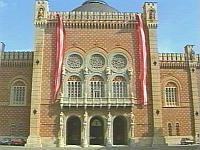While historians interpret the concept of historicism in different ways, it is mostly held to designate a methodological and philosophical attitude that spread in the German-speaking countries from the 18th century onwards.
According to F. Meinecke, Historicism emphasises an individualistic approach combined with the search for general regularities. A divergent interpretation is that commonly used in art. The term was earlier (and is partly still) used to denote a return to historical styles and given a deprecatory meaning, like "eclecticism", as applied to the "neo" styles of the 19th century.
In the meantime, it has increasingly been recognised that the phenomenon of stylistic renewal was also common in earlier periods of European art and that the novelty of the development in the 19th century lay merely in the fact that a variety of earlier styles were resorted to more or less simultaneously. As a result, the term has in recent times been used in a less negative sense.
In modern art history, Historicism stands for a particular epoch, the phase between the Baroque and the Modern Ages, which is characterised by both a reversion to mythological subjects and an espousal of realism. Like all designations of artistic epochs, the term Historicism is a rather arbitrary one and eludes exact definition. Nevertheless, the designation is indispensable. Since the work of R. Wagner-Rieger a distinction has been made between Romantic Historicism, Strict Historicism and Late Historicism, although the borderlines between them are blurred.
Romantic Historicism, characterised by subjective individualism and a tendency to idealise subjects, is fraught with contradictory features. It started in Austria in the second half of the 18th century with the revolutionary-classicist buildings designed by I. Canevale, which were followed, with some delay, by the adoption of similar principles in painting and sculpture.
The art of Romanticism, with its strong affinity with the Middle Ages, and Romantic Classicism, with its fascination with Antiquity, form part of this period. The principal area of interest was the construction of palaces and castles (Franzensburg Castle at Laxenburg, Weilburg Castle near Baden, Anif, Grafenegg) in a sentimental, elegant or pompous vein.
In painting, H. F. Füger and, after him, the Nazarenes (J. von Führich, L. Kupelwieser) and Biedermeier artists (F. Gauermann, F. Eybl, F. Amerling) were the most important representatives of the period.
The latter part of Romantic Historicism coincided with the beginning of the era of Emperor Franz Joseph. Sculptures by A. D. Fernkorn and H. Gasser attained a new level of monumentality, while A. Sicard von Sicardsburg and E. van der Nüll ascended to new artistic heights with their Opera building, which had considerable impact on further construction along the Ringstrasse boulevard. In Strict Historicism, the growth of the metropolis was the dominant concern.
In architecture, an alleged purity of style was pursued (F. von Schmidt, T. Hansen, H. Ferstel); in the fine arts, the pursuit of objectivity was foremost, with naturalist (F. G. Waldmüller) and classicist tendencies prevailing side by side. Both trends are reflected in the flowering of paintings of historic subjects. Nevertheless, Strict Historicism was a relatively short period in the history of Austrian painting and sculpture.
Late Historicism, with its fascination with the picturesque and with motion, partly inspired by (French) neo-Baroque tendencies, engendered an internationally recognised flowering of Austrian art.
The chief object of interest was the Gesamtkunstwerk ("total work of art"): theatre buildings, festive processions and sumptuous interiors received particular attention. At the same time, monumental public buildings, transport and industrial architecture increasingly became topics of public interest.
Leading architects were G. Semper and C. von Hasenauer (Court Museums, new wing of the Hofburg Imperial Palace, Burgtheater in Vienna), the partners F. Fellner and H. Helmer, who erected buildings (in particular theatres) in many countries, and O. Wagner, while H. Makart was the most influential personality in the fields of painting, fashions and the staging of public events.
Along with Makart, artists like C. Rahl, A. Romako, the young G. Klimt and the open-air painters of the circle around E. J. Schindler were the leading painters of the day; V. Tilgner, C. von Zumbusch, R. Weyr and C. Kundmann reached international standards in their monumental and decorative sculptures along the Ringstrasse.
The products of the Ringstrasse art were emulated in all parts of the Monarchy and even influenced Jugendstil, the style that heralded the end of Historicism and the beginning of modern art. The late manifestations of Historicism are in many respects intricately linked with the development of 20th century art.
In the last few decades of the 20th century, design has mainly been influenced by such modernist trend-setters as JOSEF HOFFMANN and the Wiener Werkstaette, ADOLF LOOS and ,subsequently, the artists of the BAUHAUS, while their predecessors have been somewhat neglected for what is considered a ?lack of real style? Yet, is was the artist of the late 19th century with their designs and pedagogical skills to pave the way for a modern style.
